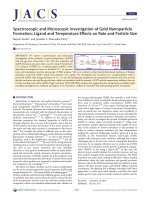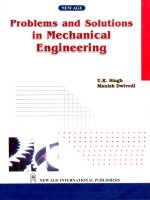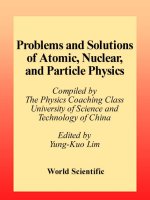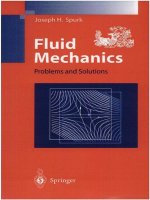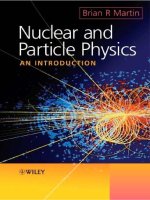- Trang chủ >>
- Khoa Học Tự Nhiên >>
- Vật lý
Problems and solutions on atomic, nuclear, and particle physics
Bạn đang xem bản rút gọn của tài liệu. Xem và tải ngay bản đầy đủ của tài liệu tại đây (4.13 MB, 727 trang )
www.pdfgrip.com
Problems and Solutions
on Atomic, Nuclear and
Particle Physics
www.pdfgrip.com
This Page Intentionally Left Blank
www.pdfgrip.com
Major American Universities Ph.D.
Qualifying Questions and Solutions
Problems and Solutions
on Atomic, Nuclear and
Particle Physics
Compiled by
The Physics Coaching Class
University of Science and
Technology of China
Edited by
Yung-Kuo Lim
National University of Singapore
World Scientific
Singapore • New Jersey • London • Hong Kong
www.pdfgrip.com
Published by
World Scientific Publishing Co. Pte. Ltd.
P 0 Box 128, Farrer Road, Singapore 912805
USA office: Suite lB, 1060 Main Street, River Edge, NJ 07661
UK office: 57 Shelton Street, Covent Garden, London WC2H 9HE
British Library Cataloguing-in-Publication Data
A catalogue record for this book is available from the British Library.
Major American Universities Ph.D. Qualifying Questions and Solutions
PROBLEMS AND SOLUTIONS ON ATOMIC, NUCLEAR AND PARTICLE PHYSICS
Copyright © 2000 by World Scientific Publishing Co. Pte. Ltd.
All rights reserved. This book, or parts, thereof may not be reproduced in any form or by any means,
electronic or mechanical, including photocopying, recording or any information storage and retrieval
system now known or to be invented, without written permission from the Publisher.
For photocopying of material in this volume, please pay a copying fee through the Copyright
Clearance Center, Inc., 222 Rosewood Drive, Danvers, MA 01923, USA. In this case permission to
photocopy is not required from the publisher.
ISBN
981-02-3917-3
981-02-3918-l
(pbk)
This book is printed on acid-free paper.
Printed
in
Singapore
by
Uto-Print
www.pdfgrip.com
PREFACE
This series of physics problems and solutions, which consists of seven
volumes — Mechanics, Electromagnetism, Optics, Atomic, Nuclear and
Particle Physics, Thermodynamics and Statistical Physics, Quantum Mechanics, Solid State Physics and Relativity, contains a selection of 2550
problems from the graduate-school entrance and qualifying examination
papers of seven U.S. universities — California University Berkeley Campus, Columbia University, Chicago University, Massachusetts Institute of
Technology, New York State University Buffalo Campus, Princeton University, Wisconsin University — as well as the CUSPEA and C.C. Ting’s
papers for selection of Chinese students for further studies in U.S.A., and
their solutions which represent the effort of more than 70 Chinese physicists,
plus some 20 more who checked the solutions.
The series is remarkable for its comprehensive coverage. In each area
the problems span a wide spectrum of topics, while many problems overlap
several areas. The problems themselves are remarkable for their versatility in applying the physical laws and principles, their uptodate realistic
situations, and their scanty demand on mathematical skills. Many of the
problems involve order-of-magnitude calculations which one often requires
in an experimental situation for estimating a quantity from a simple model.
In short, the exercises blend together the objectives of enhancement of one’s
understanding of physical principles and ability of practical application.
The solutions as presented generally just provide a guidance to solving
the problems, rather than step-by-step manipulation, and leave much to
the students to work out for themselves, of whom much is demanded of the
basic knowledge in physics. Thus the series would provide an invaluable
complement to the textbooks.
The present volume consists of 483 problems. It covers practically the
whole of the usual undergraduate syllabus in atomic, nuclear and particle
physics, but in substance and sophistication goes much beyond. Some
problems on experimental methodology have also been included.
In editing, no attempt has been made to unify the physical terms, units
and symbols. Rather, they are left to the setters’ and solvers’ own preference so as to reflect the realistic situation of the usage today. Great pains
has been taken to trace the logical steps from the first principles to the
final solution, frequently even to the extent of rewriting the entire solution.
v
www.pdfgrip.com
vi
Preface
In addition, a subject index to problems has been included to facilitate the
location of topics. These editorial efforts hopefully will enhance the value
of the volume to the students and teachers alike.
Yung-Kuo Lim
Editor
www.pdfgrip.com
INTRODUCTION
Solving problems in course work is an exercise of the mental facilities,
and examination problems are usually chosen, or set similar to such problems. Working out problems is thus an essential and important aspect of
the study of physics.
The series Major American University Ph.D. Qualifying Questions and
Solutions comprises seven volumes and is the result of months of work
of a number of Chinese physicists. The subjects of the volumes and the
respective coordinators are as follows:
1. Mechanics (Qiang Yan-qi, Gu En-pu, Cheng Jia-fu, Li Ze-hua, Yang
De-tian)
2. Electromagnetism (Zhao Shu-ping, You Jun-han, Zhu Jun-jie)
3. Optics (Bai Gui-ru, Guo Guang-can)
4. Atomic, Nuclear and Particle Physics (Jin Huai-cheng, Yang Baozhong, Fan Yang-mei)
5. Thermodynamics and Statistical Physics (Zheng Jiu-ren)
6. Quantum Mechanics (Zhang Yong-de, Zhu Dong-pei, Fan Hong-yi)
7. Solid State Physics and Miscellaneous Topics (Zhang Jia-lu, Zhou
You-yuan, Zhang Shi-ling).
These volumes, which cover almost all aspects of university physics,
contain 2550 problems, mostly solved in detail.
The problems have been carefully chosen from a total of 3100 problems, collected from the China-U.S.A. Physics Examination and Application Program, the Ph.D. Qualifying Examination on Experimental High
Energy Physics sponsored by Chao-Chong Ting, and the graduate qualifying examinations of seven world-renowned American universities: Columbia
University, the University of California at Berkeley, Massachusetts Institute of Technology, the University of Wisconsin, the University of Chicago,
Princeton University, and the State University of New York at Buffalo.
Generally speaking, examination problems in physics in American universities do not require too much mathematics. They can be characterized to a large extent as follows. Many problems are concerned with the
various frontier subjects and overlapping domains of topics, having been
selected from the setters own research encounters. These problems show a
“modern” flavor. Some problems involve a wide field and require a sharp
mind for their analysis, while others require simple and practical methods
vii
www.pdfgrip.com
viii
Introduction
demanding a fine “touch of physics”. Indeed, we believe that these problems, as a whole, reflect to some extent the characteristics of American
science and culture, as well as give a glimpse of the philosophy underlying
American education.
That being so, we considered it worthwhile to collect and solve these
problems, and introduce them to students and teachers everywhere, even
though the work was both tedious and strenuous. About a hundred teachers
and graduate students took part in this time-consuming task.
This volume on Atomic, Nuclear and Particle Physics which contains
483 problems is divided into four parts: Atomic and Molecular Physics
(142), Nuclear Physics (120), Particle Physics (90), Experimental Methods
and Miscellaneous topics (131).
In scope and depth, most of the problems conform to the usual undergraduate syllabi for atomic, nuclear and particle physics in most universities. Some of them, however, are rather profound, sophisticated, and
broad-based. In particular they demonstrate the use of fundamental principles in the latest research activities. It is hoped that the problems would
help the reader not only in enhancing understanding of the basic principles,
but also in cultivating the ability to solve practical problems in a realistic
environment.
This volume was the result of the collective efforts of forty physicists
involved in working out and checking of the solutions, notably Ren Yong,
Qian Jian-ming, Chen Tao, Cui Ning-zhuo, Mo Hai-ding, Gong Zhu-fang
and Yang Bao-zhong.
www.pdfgrip.com
CONTENTS
Preface
v
Introduction
vii
Part I. Atomic and Molecular Physics
1
1. Atomic Physics (1001–1122)
2. Molecular Physics (1123–1142)
3
173
Part II. Nuclear Physics
205
1.
2.
3.
4.
5.
6.
207
239
269
289
323
382
Basic Nuclear Properties (2001–2023)
Nuclear Binding Energy, Fission and Fusion (2024–2047)
The Deuteron and Nuclear forces (2048–2058)
Nuclear Models (2059–2075)
Nuclear Decays (2076–2107)
Nuclear Reactions (2108–2120)
Part III. Particle Physics
401
1. Interactions and Symmetries (3001–3037)
2. Weak and Electroweak Interactions, Grand Unification
Theories (3038–3071)
3. Structure of Hadrons and the Quark Model (3072–3090)
403
Part IV. Experimental Methods and Miscellaneous Topics
565
1.
2.
3.
4.
5.
567
646
664
678
690
Kinematics of High-Energy Particles (4001–4061)
Interactions between Radiation and Matter (4062–4085)
Detection Techniques and Experimental Methods (4086–4105)
Error Estimation and Statistics (4106–4118)
Particle Beams and Accelerators (4119–4131)
Index to Problems
459
524
709
ix
www.pdfgrip.com
PART I
ATOMIC AND MOLECULAR
PHYSICS
www.pdfgrip.com
This Page Intentionally Left Blank
www.pdfgrip.com
1. ATOMIC PHYSICS (1001 1122)
1001
Assume that there is an announcement of a fantastic process capable of
putting the contents of physics library on a very smooth postcard. Will it
be readable with an electron microscope? Explain.
(Columbia)
Solution:
Suppose there are 106 books in the library, 500 pages in each book, and
each page is as large as two postcards. For the postcard to be readable,
the planar magnification should be 2 × 500 × 106 ≈ 109 , corresponding to
a linear magnification of 104.5 . As the linear magnification of an electron
microscope is of the order of 800,000, its planar magnification is as large as
1011 , which is sufficient to make the postcard readable.
1002
At 1010 K the black body radiation weighs (1 ton, 1 g, 10−6 g, 10−16 g)
per cm3 .
(Columbia)
Solution:
The answer is nearest to 1 ton per cm3 .
The radiant energy density is given by u = 4σT 4 /c, where σ = 5.67 ×
−8
10 Wm−2 K−4 is the Stefan–Boltzmann constant. From Einstein’s massenergy relation, we get the mass of black body radiation per unit volume as
u = 4σT 4 /c3 = 4×5.67×10−8×1040 /(3×108 )3 ≈ 108 kg/m3 = 0.1 ton/cm3 .
1003
Compared to the electron Compton wavelength, the Bohr radius of the
hydrogen atom is approximately
(a) 100 times larger.
(b) 1000 times larger.
(c) about the same.
(CCT )
3
www.pdfgrip.com
4
Problems and Solutions in Atomic, Nuclear and Particle Physics
Solution:
The Bohr radius of the hydrogen atom and the Compton wavelength
2
h
respectively. Hence λac =
of electron are given by a = me2 and λc = mc
1 e2 −1
2π ( c )
2
= 137
2π = 22, where e / c is the fine-structure constant. Hence
the answer is (a).
1004
Estimate the electric field needed to pull an electron out of an atom in
a time comparable to that for the electron to go around the nucleus.
(Columbia)
Solution:
Consider a hydrogen-like atom of nuclear charge Ze. The ionization
energy (or the energy needed to eject the electron) is 13.6Z2 eV. The orbiting electron has an average distance from the nucleus of a = a0 /Z, where
a0 = 0.53 × 10−8 cm is the Bohr radius. The electron in going around the
nucleus in electric field E can in half a cycle acquire an energy eEa. Thus
to eject the electron we require
eEa
13.6 Z2 eV ,
or
E
13.6 Z3
≈ 2 × 109 Z3 V/cm .
0.53 × 10−8
1005
As one goes away from the center of an atom, the electron density
(a) decreases like a Gaussian.
(b) decreases exponentially.
(c) oscillates with slowly decreasing amplitude.
(CCT )
www.pdfgrip.com
Atomic and Molecular Physics
5
Solution:
The answer is (c).
1006
An electronic transition in ions of 12 C leads to photon emission near
λ = 500 nm (hν = 2.5 eV). The ions are in thermal equilibrium at an
ion temperature kT = 20 eV, a density n = 1024 m−3 , and a non-uniform
magnetic field which ranges up to B = 1 Tesla.
(a) Briefly discuss broadening mechanisms which might cause the transition to have an observed width ∆λ greater than that obtained for very
small values of T , n and B.
(b) For one of these mechanisms calculate the broadened width ∆λ using
order-of-magnitude estimates of needed parameters.
(Wisconsin)
Solution:
(a) A spectral line always has an inherent width produced by uncertainty
in atomic energy levels, which arises from the finite length of time involved
in the radiation process, through Heisenberg’s uncertainty principle. The
observed broadening may also be caused by instrumental limitations such
as those due to lens aberration, diffraction, etc. In addition the main causes
of broadening are the following.
Doppler effect: Atoms or molecules are in constant thermal motion at
T > 0 K. The observed frequency of a spectral line may be slightly changed
if the motion of the radiating atom has a component in the line of sight, due
to Doppler effect. As the atoms or molecules have a distribution of velocity
a line that is emitted by the atoms will comprise a range of frequencies
symmetrically distributed about the natural frequency, contributing to the
observed width.
Collisions: An atomic system may be disturbed by external influences
such as electric and magnetic fields due to outside sources or neighboring
atoms. But these usually cause a shift in the energy levels rather than
broadening them. Broadening, however, can result from atomic collisions
which cause phase changes in the emitted radiation and consequently a
spread in the energy.
www.pdfgrip.com
6
Problems and Solutions in Atomic, Nuclear and Particle Physics
(b) Doppler broadening: The first order Doppler frequency shift is given
by ∆ν = ν0cvx , taking the x-axis along the line of sight. Maxwell’s velocity
distribution law then gives
dn ∝ exp −
M vx2
2kT
dvx = exp −
M c2
2kT
∆ν
ν0
2
dvx ,
where M is the mass of the radiating atom. The frequency-distribution of
the radiation intensity follows the same relationship. At half the maximum
intensity, we have
(ln 2)2kT
∆ν = ν0
.
M c2
Hence the line width at half the maximum intensity is
2∆ν =
In terms of wave number ν˜ =
1
λ
=
1.67c
λ0
ν
c
ν=
ΓD = 2∆˜
2kT
.
M c2
we have
1.67
λ0
2kT
.
M c2
With kT = 20 eV, M c2 = 12 × 938 MeV, λ0 = 5 × 10−7 m,
ΓD =
1.67
5 × 10−7
2 × 20
= 199 m−1 ≈ 2 cm−1 .
12 × 938 × 106
Collision broadening: The mean free path for collision l is defined by
nlπd2 = 1, where d is the effective atomic diameter for a collision close
enough to affect the radiation process. The mean velocity v¯ of an atom can
be approximated by its root-mean-square velocity given by 12 M v 2 = 32 kT .
Hence
3kT
v¯ ≈
.
M
Then the mean time between successive collisions is
t=
1
l
=
v¯
nπd2
M
.
3kT
www.pdfgrip.com
Atomic and Molecular Physics
7
The uncertainty in energy because of collisions, ∆E, can be estimated from
the uncertainty principle ∆E · t ≈ , which gives
∆νc ≈
1
,
2πt
or, in terms of wave number,
Γc =
1 2
nd
2
3 × 10−3
3kT
∼
M c2
λ0
2kT
,
M c2
if we take d ≈ 2a0 ∼ 10−10 m, a0 being the Bohr radius. This is much
smaller than Doppler broadening at the given ion density.
1007
(I) The ionization energy EI of the first three elements are
Z
1
2
3
Element
H
He
Li
EI
13.6 eV
24.6 eV
5.4 eV
(a) Explain qualitatively the change in EI from H to He to Li.
(b) What is the second ionization energy of He, that is the energy required to remove the second electron after the first one is removed?
(c) The energy levels of the n = 3 states of the valence electron of
sodium (neglecting intrinsic spin) are shown in Fig. 1.1.
Why do the energies depend on the quantum number l?
(SUNY, Buffalo)
Fig. 1.1
www.pdfgrip.com
8
Problems and Solutions in Atomic, Nuclear and Particle Physics
Solution:
(a) The table shows that the ionization energy of He is much larger than
that of H. The main reason is that the nuclear charge of He is twice than
that of H while all their electrons are in the first shell, which means that the
potential energy of the electrons are much lower in the case of He. The very
low ionization energy of Li is due to the screening of the nuclear charge by
the electrons in the inner shell. Thus for the electron in the outer shell, the
effective nuclear charge becomes small and accordingly its potential energy
becomes higher, which means that the energy required for its removal is
smaller.
(b) The energy levels of a hydrogen-like atom are given by
En = −
Z2
× 13.6 eV .
n2
For Z = 2, n = 1 we have
EI = 4 × 13.6 = 54.4 eV .
(c) For the n = 3 states the smaller l the valence electron has, the larger
is the eccentricity of its orbit, which tends to make the atomic nucleus
more polarized. Furthermore, the smaller l is, the larger is the effect of
orbital penetration. These effects make the potential energy of the electron
decrease with decreasing l.
1008
Describe briefly each of the following effects or, in the case of rules, state
the rule:
(a) Auger effect
(b) Anomalous Zeeman effect
(c) Lamb shift
(d) Land´e interval rule
(e) Hund’s rules for atomic levels
(Wisconsin)
Solution:
(a) Auger effect: When an electron in the inner shell (say K shell) of
an atom is ejected, a less energetically bound electron (say an L electron)
www.pdfgrip.com
Atomic and Molecular Physics
9
may jump into the hole left by the ejected electron, emitting a photon. If
the process takes place without radiating a photon but, instead, a higherenergy shell (say L shell) is ionized by ejecting an electron, the process is
called Auger effect and the electron so ejected is called Auger electron. The
atom becomes doubly ionized and the process is known as a nonradiative
transition.
(b) Anomalous Zeeman effect: It was observed by Zeeman in 1896 that,
when an excited atom is placed in an external magnetic field, the spectral
line emitted in the de-excitation process splits into three lines with equal
spacings. This is called normal Zeeman effect as such a splitting could
be understood on the basis of a classical theory developed by Lorentz.
However it was soon found that more commonly the number of splitting of
a spectral line is quite different, usually greater than three. Such a splitting
could not be explained until the introduction of electron spin, thus the name
‘anomalous Zeeman effect’.
In the modern quantum theory, both effects can be readily understood:
When an atom is placed in a weak magnetic field, on account of the interaction between the total magnetic dipole moment of the atom and the
external magnetic field, both the initial and final energy levels are split
into several components. The optical transitions between the two multiplets then give rise to several lines. The normal Zeeman effect is actually
only a special case where the transitions are between singlet states in an
atom with an even number of optically active electrons.
(c) Lamb shift: In the absence of hyperfine structure, the 22 S1/2 and
22 P1/2 states of hydrogen atom would be degenerate for orbital quantum number l as they correspond to the same total angular momentum
j = 1/2. However, Lamb observed experimentally that the energy of 22 S1/2
is 0.035 cm−1 higher than that of 22 P1/2 . This phenomenon is called Lamb
shift. It is caused by the interaction between the electron and an electromagnetic radiation field.
(d) Land´e interval rule: For LS coupling, the energy difference between
two adjacent J levels is proportional, in a given LS term, to the larger of
the two values of J.
(e) Hund’s rules for atomic levels are as follows:
(1) If an electronic configuration has more than one spectroscopic notation, the one with the maximum total spin S has the lowest energy.
(2) If the maximum total spin S corresponds to several spectroscopic
notations, the one with the maximum L has the lowest energy.
www.pdfgrip.com
10
Problems and Solutions in Atomic, Nuclear and Particle Physics
(3) If the outer shell of the atom is less than half full, the spectroscopic
notation with the minimum total angular momentum J has the lowest energy. However, if the shell is more than half full the spectroscopic notation
with the maximum J has the lowest energy. This rule only holds for LS
coupling.
1009
Give expressions for the following quantities in terms of e, , c, k, me and
mp .
(a) The energy needed to ionize a hydrogen atom.
(b) The difference in frequency of the Lyman alpha line in hydrogen
and deuterium atoms.
(c) The magnetic moment of the electron.
(d) The spread in measurement of the π 0 mass, given that the π 0 lifetime
is τ .
(e) The magnetic field B at which there is a 10−4 excess of free protons
in one spin direction at a temperature T .
(f) Fine structure splitting in the n = 2 state of hydrogen.
(Columbia)
Solution:
(a)
EI =
e2
4πε0
2
me
,
2 2
ε0 being the permittivity of free space.
(b) The difference of frequency is caused by the Rydberg constant changing with the mass of the nucleus. The wave number of the α line of hydrogen
atom is
1
3
ν˜H = RH 1 −
= RH ,
4
4
and that of the α line of deuterium atom is
ν˜D =
3
RD .
4
The Rydberg constant is given by
www.pdfgrip.com
Atomic and Molecular Physics
2
e2
4πε0
R=
11
mr
mr
=
R∞ ,
me
me
where mr is the reduced mass of the orbiting electron in the atomic system,
and
2
e2
me
.
R∞ =
4πε0
4π 3 c
As for H atom, mr =
mp me
mp +me ,
and for D atom,
mr =
2mp me
,
2mp + me
mp being the nucleon mass, we have
∆ν = c∆˜
ν=
≈
1
3
1
3
c(RD − RH ) = cR∞
me −
me
4
4
1+
1+
2mp
mp
3
me
3
cR∞
=
4
2mp
4
e2
4πε0
2
π 2 m2e
.
h3 mp
(c) The magnetic moment associated with the electron spin is
µe =
he
= µB ,
4πme
µB being the Bohr magneton.
(d) The spread in the measured mass (in energy units) is related to the
lifetime τ through the uncertainty principle
∆E · τ
,
which gives
∆E
τ
.
(e) Consider the free protons as an ideal gas in which the proton spins
have two quantized directions: parallel to B with energy Ep = −µp B and
www.pdfgrip.com
12
Problems and Solutions in Atomic, Nuclear and Particle Physics
e
2mp
−E
exp( kTp ),
antiparallel to B with energy Ep = µp B, where µp =
is the magnetic
moment of proton. As the number density n ∝
we have
exp
exp
µp B
kT
µp B
kT
−µp B
kT
−µp B
kT
− exp
+ exp
or
2µp B
kT
exp
=
= 104 ,
1 + 104
,
1 104
giving
2àp B
2 ì 104 ,
kT
i.e.
B=
kT
ì 104 .
àp
(f) The quantum numbers of n = 2 states are: n = 2, l = 1, j1 = 3/2,
j2 = 1/2 (the l = 0 state does not split and so need not be considered here).
From the expression for the fine-structure energy levels of hydrogen, we get
∆E = −
2πRhcα2
n3
1
j1 +
where
α=
1
2
−
πRhcα2
=
,
1
8
j2 +
2
1
e2
4πε0 c
is the fine structure constant,
R=
e2
4πε0
2
me
4π 3 c
is the Rydberg constant.
1010
As shown in Fig. 1.2, light shines on sodium atoms. Estimate the crosssection on resonance for excitation of the atoms from the ground to the
www.pdfgrip.com
Atomic and Molecular Physics
13
Fig. 1.2
first excited state (corresponding to the familiar yellow line). Estimate
the width of the resonance. You need not derive these results from first
principles if you remember the appropriate heuristic arguments.
(Princeton)
Solution:
The cross-section is defined by σA = Pω /Iω , where Pω dω is the energy
in the frequency range ω to ω+dω absorbed by the atoms in unit time, Iω dω
is the incident energy per unit area per unit time in the same frequency
range. By definition,
Pω dω = B12 ωNω ,
where B12 is Einstein’s B-coefficient giving the probability of an atom in
state 1 absorbing a quantum ω per unit time and Nω dω is the energy
density in the frequency range ω to ω + dω. Einstein’s relation
B12 =
π2 c3 g1
· A21
ω 3 g2
gives
B12 =
π2 c3 g1
π2 c3 g1 1
·
· = 2 3 · Γ,
3
ω
g2 τ
ω g2
where τ is the lifetime of excited state 2, whose natural line width is Γ ≈ τ ,
g1 , g2 are respectively the degeneracies of states 1 and 2, use having been
made of the relation A12 = 1/τ and the uncertainty principle Γτ ≈ . Then
as Nω = Iω /c, c being the velocity of light in free space, we have
Pω =
π 2 c2 g1
· ΓIω .
ω 2 g2
www.pdfgrip.com
14
Problems and Solutions in Atomic, Nuclear and Particle Physics
Introducing the form factor g(ω) and considering ω and Iω as average values
in the band of g(ω), we can write the above as
π 2 c2 g1
· ΓIω g(ω) .
ω 2 g2
Pω =
Take for g(ω) the Lorentz profile
g(ω) =
Γ
2π
(E2 − E1 − ω)2 +
Γ2
4
.
At resonance,
E2 − E1 = ω ,
and so
g ω=
Hence
σA =
E2 − E1
=
2
.
πΓ
2πc2 g1
π2 c2 g1 2
=
·
·
·
.
ω 2 g2 π
ω 2 g2
A, and
For the yellow light of Na (D line), g1 = 2, g2 = 6, λ = 5890 ˚
1 λ2
·
= 1.84 × 10−10 cm2 .
3 2π
For the D line of sodium, τ ≈ 10−8 s and the line width at half intensity is
σA =
Γ≈
τ
= 6.6 × 10−8 eV .
As
Γ = ∆E = ∆ω = ∆
2πc
λ
= 2π c∆˜
ν,
the line width in wave numbers is
Γ
1
∆˜
ν=
≈
= 5.3 × 10−4 cm−1 .
2π c
2πcτ
1011
The cross section for electron impact excitation of a certain atomic level
A is σA = 1.4 × 10−20 cm2 . The level has a lifetime τ = 2 × 10−8 sec, and
decays 10 per cent of the time to level B and 90 per cent of the time to
level C (Fig. 1.3).
www.pdfgrip.com
Atomic and Molecular Physics
15
Fig. 1.3
(a) Calculate the equilibrium population per cm3 in level A when an
electron beam of 5 mA/cm2 is passed through a vapor of these atoms at a
pressure of 0.05 torr.
(b) Calculate the light intensity emitted per cm3 in the transition A →
B, expressed in watts/steradian.
(Wisconsin)
Solution:
(a) According to Einstein’s relation, the number of transitions B, C → A
per unit time (rate of production of A) is
dNBC→A
= n0 σA NBC ,
dt
and the number of decays A → B, C per unit time is
dNA→BC
=
dt
1
+ n0 σA NA ,
τ
where NBC and NA are the numbers of atoms in the energy levels B, C
and A respectively, n0 is the number of electrons crossing unit area per unit
time. At equilibrium,
dNBC→A
dNA→BC
=
,
dt
dt
giving
NA =
n0 σA N
≈ n0 σA N τ ,
1
+ 2n0 σA
τ
(N = NA + NBC )
as n0 = 5 × 10−3 /1.6 × 10−19 = 3.1 × 1016 cm−2 s−1 and so
www.pdfgrip.com
1
τ
2n0 σA .
